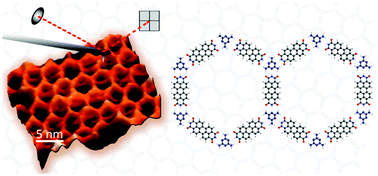Bimolecular porous supramolecular networks deposited from solution on layered materials: graphite, boron nitride and molybdenum disulphide†
Abstract
A two-dimensional porous network formed from perylene tetracarboxylic diimide (PTCDI) and melamine may be deposited from solution on the surfaces of highly oriented pyrolytic graphite (HOPG), hexagonal boron nitride (hBN) and molybdenum disulphide (MoS2). Images acquired using high resolution atomic force microscopy (AFM) operating under ambient conditions have revealed that the network forms extended ordered monolayers (>1 μm2) on HOPG and hBN whereas on MoS2 much smaller islands are observed.

- This article is part of the themed collection: Scanning Probe Studies of Molecular Systems

 Please wait while we load your content...
Please wait while we load your content...